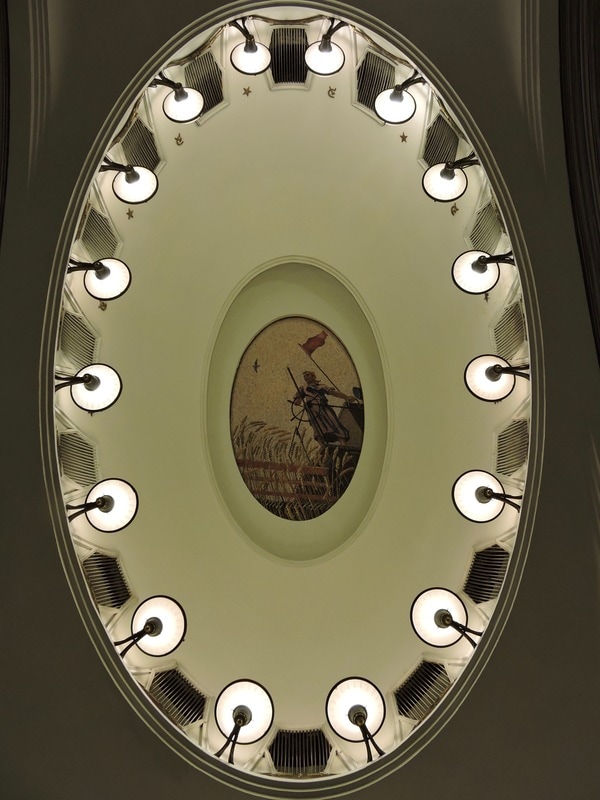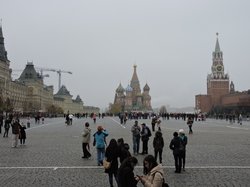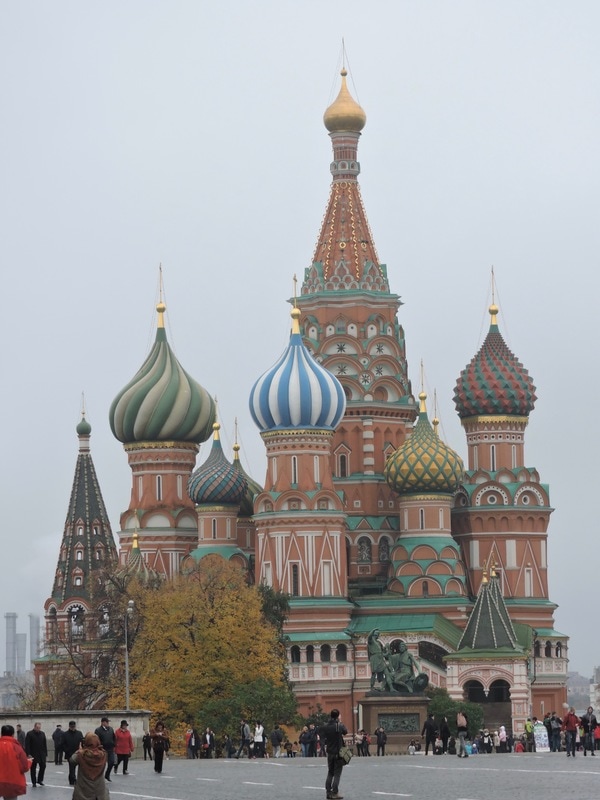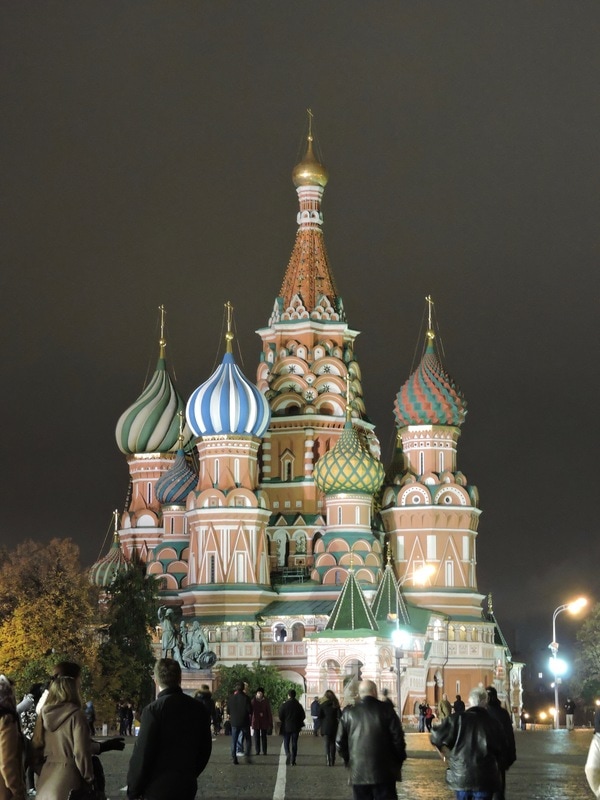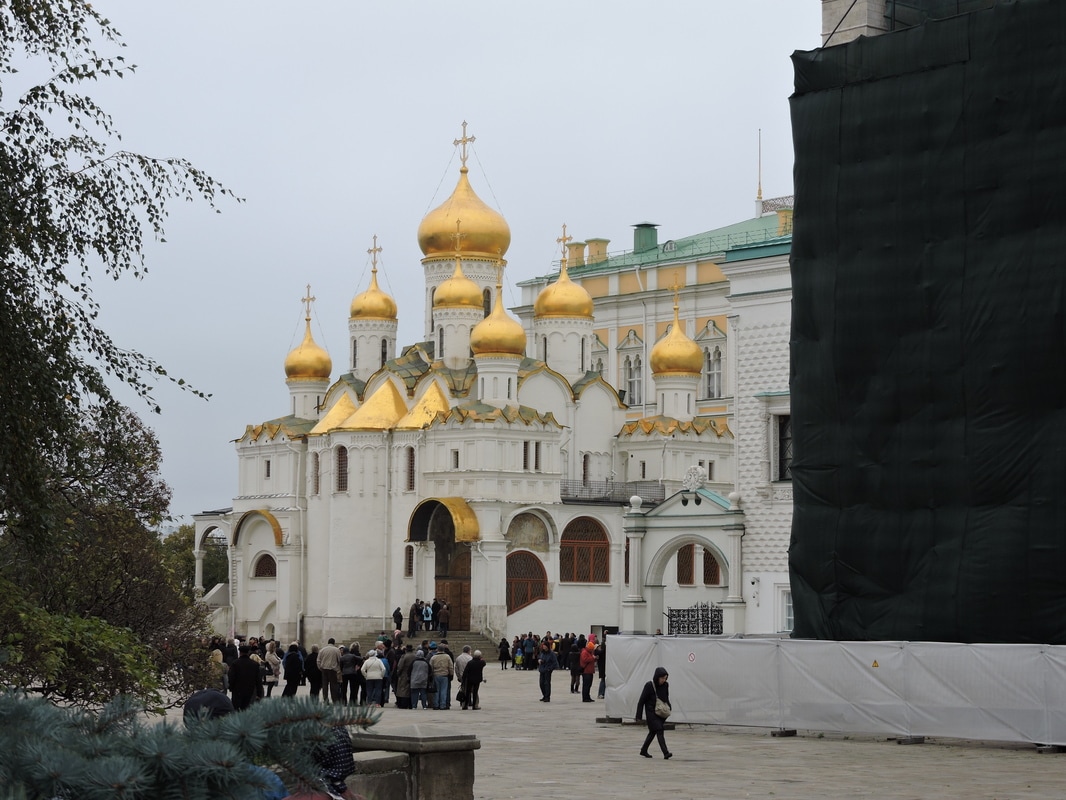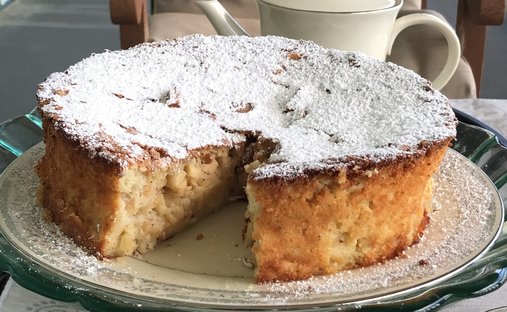
Our adventures in Russia concluded in Moscow, the nation’s capital and a city of more than twelve million people. In very chilly weather, we disembarked from our river boat and drove for about two hours past thriving businesses and sturdy brick Stalin-era apartment buildings constructed to withstand the brutal weather. Our destination was the Moscow Metro, a bustling place with walls and interior ceilings decorated with Soviet era art and sculpture. After surviving the Metro’s long and nearly vertical escalators, we continued with a walking tour of about six miles around Moscow’s Red Square and the Kremlin.
|
|
At Red Square, the green
Domes of St. Basil’s and the
Cold smell of dried fish.
|
Red Square, a stunning and enormous public area surrounding the Kremlin, was hosting a harvest fair when we arrived. Booths decorated with pumpkins were selling all sorts of snacks, including sausages, meat kabobs, fish in many forms and the ever-popular piroshkies. We also had an awe inspiring up close view of St. Basil’s Cathedral, perhaps Russia’s most famous landmark, occupying one end of Red Square. Built between 1555 and 1560, this magnificent church consists of nine individual chapels constructed on a single foundation and topped by a set of intensely colored domes of varying heights. Commissioned by Russia’s first Tsar, Ivan the Terrible, this unique architectural masterpiece has loosely Byzantine origins but also may be influenced by the style of the domed wooden churches of northern Russia, such as the lovely wooden churches on Kizhi Island. St. Basil’s however, is built of red brick on a white stone foundation. Architectural historians can find no analog in the designs of other Russian churches, and some scholars conjecture that the gilded tin high rising domes, in red white and golden colors, are intended to depict flames rising toward heaven. Others surmise that the green and blue ceramic inserts on the domes suggest the Biblical rainbow.
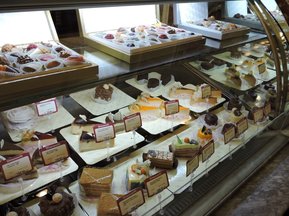
Whatever the architects’ intentions, St. Basil’s has captured the imaginations of artists, folklorists, and ordinary people for centuries, even influencing the “castles” at Disneyland. We returned at night for another view of St. Basil’s, and it was even more beautiful in darkness with its flaming domes lighting up the night sky. In ironic contrast, another famous occupant of Red Square is GUM department store, an elegant, over-the-top shopping center that rivals Harrods of London, Mitsukoshi of Tokyo and New York’s Fifth Avenue. We focused on the Food Hall, a massive and decorative array of meats of every kind, including whole cooked pigs, fish and caviar, cheeses, breads, wines and liquor, including Vodka of course, pastries and candies.

We bought a large bag of assorted Red October chocolates, Russia’s favorite candies. They come in thirty different kinds of flavors and fillings, each individual piece in a bright, artistic wrapping. The most popular Red October candy is Alenka, a milk chocolate whose wrapping depicts an adorable little girl wearing a colorful headscarf. We found Red October candies quite delicious and indeed addictive. The huge six-story red brick factory where these historic candies were made for more than a hundred years is now a museum and trendy visitors’ hot spot. But not to worry; Red October chocolates are still being produced in a modern factory in one of Moscow’s suburbs, and one can even order Red October treats on line at Amazon.
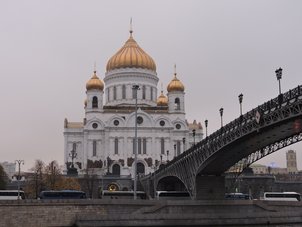
Our walking tour took us from Red Square to the nearby Cathedral of Christ the Savior, a beautiful white church with gleaming golden domes. This massive structure, the tallest Orthodox Christian church in the world, has been completely rebuilt in the Russian Revival style after the original was blown up by the communists. Completed in 1999, the new church is decorated with elegant interior frescos and icons and is a functioning cathedral. On our tour of the interior, lured by the sound of glorious a cappella singing, we tiptoed downstairs to a chapel where mass was just starting. The priest in his gold-embroidered green vestments carried a golden thurible on a chain, spreading incense throughout the chapel as the congregation chanted in unison. We were privileged to witness this numinous, sacred moment.

That evening, we witnessed another example of the Russian love for beauty, reverence and artistic excellence on the highest level. We were treated to a Russian folk music recital by a very talented group of young people who played traditional instruments, many of which I did not recognize. We saw and heard balalaikas, dulcimer-like stringed instruments, an auto-harp or koto-like stringed instrument, accordions, drums and flutes. The performance was delightful, the music beautiful and the musicians obviously accomplished. I only wish I were less ignorant about the history of Russian folk music and traditional instruments.
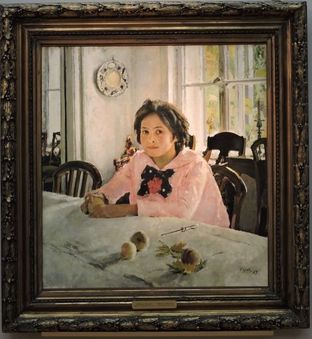
The next morning, we drove once more past the Cathedral of Christ the Savior, gleaming in the very cold morning sun light, on our way to the Tretyakov Art Gallery to view an impressive collection of Russian art. We saw mostly Eighteenth to Twentieth Century portraits, landscapes, historical and allegorical paintings, but also some very fine icons. Once again I was reminded how tragic it is that Americans, perhaps because of the many years of the Cold War, are taught nothing about Russian art in our public education, and I was again embarrassed by my own ignorance yet determined to learn more. Let me share a brief listing of some of the paintings that seemed to me especially skillful and significant: Alexander Ivanoff’s The Appearance of Christ to the People, a huge canvas which
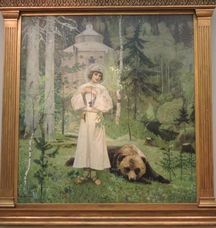
took the artist twenty years to paint; a portrait of the writer, Fyodor Dostoyevsky, author of Crime and Punishment and other classics, by Vasily Perov and The Temptation of Christ in the Desert by Ivan Kramskoy. One work I did recognize was Morning in a Pine Forest, a very realistic painting of four bears in the woods by Ivan Shishken. Valentin Serov’s exquisite Girl with Peaches is perhaps the masterpiece of the Tretyakov Gallery. Another intriguing painting is Mikhail Nesterov’s 1897 work Youth of St. Sergius. In this painting, a pale and holy looking young man stands outdoors in a white and green forest setting with an oversized panda lying on the ground next to him. I was fascinated by the realistic and intricate detail of the setting and the mysteriously spiritual effect of the painting as a whole.
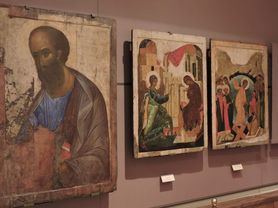
The Tretyakov also has a comprehensive and well-presented collection of Russian icons from a variety of time periods and artistic styles. Among my favorites were painted icons of St. John in Patmos, St George and the Dragon, and a mosaic icon of Dmitry of Thessalonica. Subsequent to my visit to the Tretyakov Gallery, I researched all of the paintings mentioned above and other works by Russian artists on line. I encourage everyone to explore Russia’s monumental contribution to Art History. To begin, try googling the Tretyakov Gallery, as not surprisingly, this state owned museum houses the finest collection of Russian art in the world.
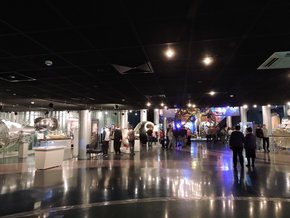
We returned to the modern age in the afternoon with a visit to the Cosmonaut Museum. This interesting and accessible museum is located in a pleasant park setting dominated by a large slender titanium obelisk entitled Monument to the Conquerors of Space. This sculptural giant depicting a rocket rising on its exhaust plume was erected in 1964 to celebrate the dawn of the space age, and indeed it was the Russians who first entered outer space. The two-story museum is well designed with a gentle ramp, allowing the disabled as well as the exhausted to view the exhibits on both levels without exertion. The collection included actual space crafts, space suits, part of a rocket that landed on the moon, meteors and even the packaged foods including the dehydrated sour cream that was deemed essential for the Russian cosmonauts to take with them into outer space.
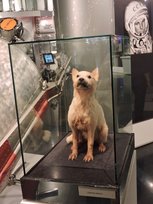
We were startled by the two cute little taxidermy dogs who, while they were alive, were sent into orbit early in the Russian space program and returned safely. The notes on their exhibit assured visitors that both little females subsequently lived long and happy lives prior to becoming museum exhibits. As expected, there was also plenty of information about Yuri Gargarin, the Russian pilot and cosmonaut who in 1961 became the first man in outer space, orbiting the earth aboard the Vostok 1. We were charmed to see that the museum also displayed a collegial attitude toward the American space program with a large photograph of the three American astronauts who were the first to land on the moon, Neil Armstrong, Buzz Aldrin and Michael Collins, who took Apollo 11 to the moon in 1969. And a display in the Cosmonaut Museum admits that Russia has made four attempts to send a manned rocket to the moon, and all four efforts have failed.
|
Marigolds at the
Cold Kremlin bloom beneath the
Gold domed cathedrals
|
|
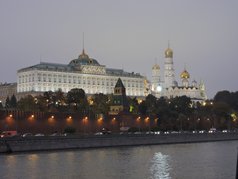
After an evening of viewing the lights of Moscow from Sparrow Hill, the highest point in the city, enjoying the magnificent architecture of the University of Moscow, and taking in the lights of Red Square and the Kremlin at night by boat in the freezing cold, we had just enough energy for a daytime walking tour of the Kremlin, bitterly cold even in the morning sun. As we know, the word “kremlin” refers to the fortified governmental center of any Russian city, but “The Kremlin” always brings to mind Moscow’s Kremlin, the center of the Russian government. This massive walled area, protected by tall brick guard towers, overlooks the Moskva River to the south, St. Basil’s Cathedral and Red Square to the east and the Alexander Garden to the west. It is a UNESCO World Heritage Center. Occupied by ancient people since the Second Century B.C., the Kremlin now houses four cathedrals, five palaces, museums, government buildings and the official residence of the President of the Russian Federation.
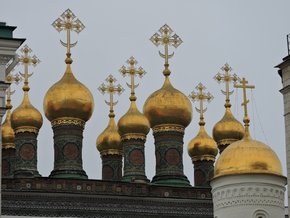
Our tour of the Kremlin took us to two magnificent gold-domed cathedrals, St. Michael Archangel Cathedral and the Cathedral of the Dormition of the Blessed Virgin Mary, also called the Assumption Cathedral. This latter cathedral was founded in 1406 and is filled with gloriously gilded icons covering all of the walls. The crown jewel of the Assumption Cathedral is an especially beautiful Dormition icon, painted in 1479, depicting Jesus and his Apostles calling the Virgin Mary to heaven. The equally beautiful Archangel Michael Cathedral contains a large number of tombs, including the tomb of Ivan the Terrible, Russia’s first Tsar. A little research leads us to conclude that the word “terrible” originally meant “inspiring fear or terror,” so a better title to describe Ivan might be Ivan the Formidable or perhaps even Ivan the Awesome. In any case, these two lovely Cathedrals in the Kremlin were significant in Ivan’s life, as he was crowned first Tsar of All Russia in the Dormition Cathedral in 1547 and buried in St. Michael Archangel in 1584. A fascinating figure in Russian history whose behavior was on occasion terrible, Ivan transformed Russia from a medieval collection of towns and cities to a major empire, symbolized even today by the Kremlin.
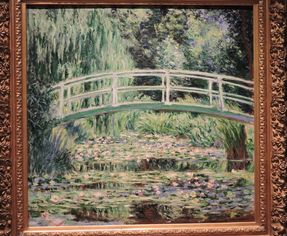
In the afternoon of our final day in Russia we visited one of the four buildings of the Pushkin Museum, the one containing a world class collection of Impressionist and Post-Impressionist paintings. Wayne and I both love the Impressionists and have seen excellent exhibits in the Louvre, in Holland, in Japan where the Impressionists are deeply appreciated, and in many other museums elsewhere in Europe and Asia and throughout the United States, but we felt that the Pushkin had an excellent selection by all of the best painters in this genre. Every name in the Impressionist and Post-Impressionist panoply was well represented, including works by Monet depicting a Japanese bridge with waterlilies and Rouen Cathedral, familiar motifs by this most beloved painter. I was also drawn to a deeply colorful and breathtaking painting by van Gough entitled “The Red Vineyard at Arles.” Painted in 1888, legend has it that this beautiful work is the only painting sold by van Gogh during his own lifetime. This painting alone is worth a visit to the Pushkin Museum.
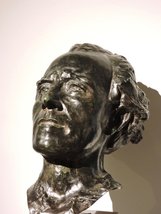
We said a poignant farewell to Russia, a clean and orderly country filled with friendly, hard- working people, good food and a passion for painting, literature, music, dance and folk crafts of the very highest standards. As a concluding thought, I will share with you that while many North Americans have read the works of Dostoyevsky, Tolstoy or Chekov, either as college assignments or for personal pleasure, it is the writings of Alexander Pushkin that have captured and remain in the hearts of the Russian people. This poet, novelist, playwright and writer of folk tales of the Romantic era lived only briefly from 1799 to 1837, when he died in a duel defending his wife’s honor. But there are statues of Pushkin all over Russian, and he is loved throughout his native land as the founder of modern Russian literature. I have put Pushkin on my reading list. I think I’ll start with his Fairy Tales, and picture the beautiful Russian countryside as I read them.
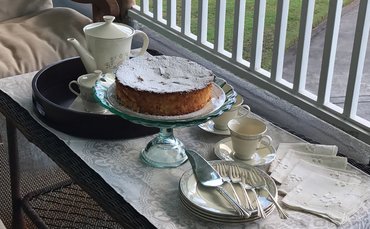
Meanwhile, I will leave you with a recipe for Russian Apple Sponge Cake to eat with a cup of Russian Caravan Tea while you are reading Pushkin. This is the cake that we were served in Uglich by Rita the icon artist when we visited her and her husband Vladimir in their home. (See my February 2017 blog, Relishing Russia Part II: Along the Waterways.) It’s also perfectly all right to serve this cake with Irish Breakfast Tea (or even Irish Coffee) at your St. Patrick’s Day party this month, as both the Russians and the Irish live in cold countries where apples are plentiful and everyone loves good literature, good music and good food. Don’t forget that we have a lovely Russian Tea menu as well as a St. Patrick’s Day Tea menu at myteaplanner.com, the Road Back to Civilization. Finally, take a look at Kathleen’s blog this month on Cake Pedestals. This simple yet elegant Apple Cake would look gorgeous served on your best cake pedestal.
Apple Sharlotka
(Russian Apple Sponge Cake)
This light, airy cake, filled with chopped apples, is like a little black dress or a navy blazer. It is welcome at any occasion, and its true charm is its simplicity. Called a Sharlotka Cake (Apple Charlotte) in Russia, this pastry is popular throughout the country and can be served at any time of the day, although it is traditional to serve it in the evening with hot tea after dinner. In its simplest form, Apple Sharlotka contains only four ingredients, eggs, sugar, flour and chopped apples, no butter, spices or nuts. Other versions call for the addition of vanilla, baking powder, salt, cinnamon, or even raisins and walnuts. I have chosen the middle road, and include very small amounts of almond extract, nutmeg, lemon juice and salt. A dusting of powdered sugar on top is all an Apple Sharlotka needs, although you could serve this delicious cake with sour cream or vanilla ice cream.
Please note that it is difficult to discern when this cake is done, as the batter can remain doughy as it mingles with the chopped apples. Using an oblong glass baking pan will make it easier to see when the cake is fully cooked, but a spring form pan makes a very attractive presentation. You will have to test carefully with a wooden skewer to determine when this cake is done.
- 6 eggs at room temperature
- 1 cup plus 2 tablespoons sugar
- ¼ teaspoon almond extract
- 1 cup flour
- ¼ teaspoon baking powder
- ¼ teaspoon nutmeg
- pinch of salt
- 1 tablespoon fresh lemon juice (from half a lemon)
- 2 large apples, Granny Smith or Fuji
- cooking spray
- powdered sugar for sifting over the top
Preheat oven to 350°F
Special equipment: large mixing bowl, 2 medium sized mixing bowls, sifter or sieve, parchment paper, aluminum foil, plastic wrap, electric mixer, citrus juicer, paring knife, wooden spoon, colander, rubber spatula, 10” or 11″ spring form pan, (or 13” x 9” glass baking pan) large baking sheet, wooden skewer, wire rack, cake pedestal for presentation
Makes: one 10” cake, 8-12 servings
- Spray the bottom and sides of a 10” or 11″ spring form pan with cooking spray. Line the bottom with a round of parchment paper. Spray the parchment. Place the prepared pan on a foil lined baking sheet and set aside. If using a glass pan or Bundt pan, spray with cooking spray, but do not line with parchment.
- Sift the flour, baking powder, salt and nutmeg into a medium sized bowl and set aside. In another medium sized bowl, mix 2 tablespoons of sugar and 1 tablespoon of lemon juice. Peel and core three apples, one at a time, and cut each apple into very small pieces, adding the apple pieces to the sugar and lemon juice and stirring the mixture with a wooden spoon to coat the apples as you proceed. Cover the bowl of apple pieces with plastic wrap and set aside.
- Combine the eggs, 1 cup of sugar and almond extract in a large mixing bowl and beat with an electric mixer for about 8 minutes until the mixture is thick, very foamy and light yellow in color. Add the flour, a small amount at a time, to the egg mixture and fold it in with a rubber spatula, using an over and under motion, until no flour is still visible.
- Place the apple mixture in a colander to drain off the lemon juice. Gently fold the apple pieces into the batter to distribute evenly, and pour the mixture into the prepared pan. Smooth the top of the cake with a spatula and bake it for approximately 1 hour or more until a wooden skewer comes out clean.
- Cool on a wire rack for 15 minutes. If using a glass pan, sift powdered sugar over the cake and serve while still warm. If using a spring form pan, remove the cake from the pan, peel off the parchment and place the cake on a cake pedestal or serving plate. Sift powdered sugar over the warm cake.
Note: This cake can be served while warm or refrigerated and served chilled or at room temperature.
